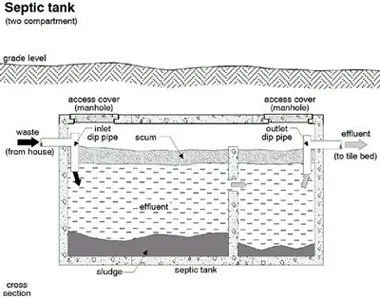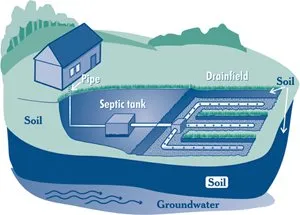Septic Maintenance
Cleaning Your Septic Tank
The most important step to achieving trouble-free septic system operation is to remove the solids from the tank before they start to wash out into the absorption field and before the system starts showing signs of failure. Remember, once the soil absorption system is clogged, cleaning the tank will do little good — you will need a new leach field.
Frequency of Cleaning
How often your tank will need pumping depends largely on the size of the tank, the number of people in the household, and the kinds of appliances you use. As a general rule, tanks should be cleaned every three to five years, but the period can vary considerably. The best procedure is to inspect your tank every year and have it pumped as necessary. If your system hasn’t been inspected in two years or more, have it done now. You have a considerable investment in your septic system — the cost of periodic pumping is nominal compared to the cost of replacing a neglected or failed system.


How a Septic System Works
Septic systems are buried in the ground near the home they serve. They have two main parts: the septic tank and a soil absorption system (“the leach field” or “drain field”). The tank receives the wastewater from the home and removes most of the solids so that the liquid can easily soak into the ground without clogging the soil pores.
The Septic Tank and Leach Field
The tank holds 1,000 to 1,500 gallons and is usually made of concrete or fiberglass. A typical tank is about eight feet long and five feet deep and wide. It has interior baffles to help it retain solids, and manholes on the top permit inspection and cleaning. Heavy solids form sludge at the bottom of the tank, and grease and light material form a scum near the top. Bacteria in the tank can break down some of these solids.
The liquid effluent from the septic tank is distributed to the leach field. Serious difficulties occur when the leach field becomes clogged. The most common cause of leach field clogging is carryover of solids from the septic tank. When sludge and scum are not periodically moved from the tank, either the perforated distribution pipe or the pores in the soil become clogged. Another major cause of clogging would be roots stemming from deep-rooted trees in the surrounding area
Other Maintenance Tips
- Record the location of your septic tank: Once you have found your tank, make a diagram showing exactly where it is. Keep one copy with your deed and another where it will be handy.
- Install risers: Another way to save future searching and digging is to install risers from the septic tank with access lids at or near ground level. Risers can be constructed out of redwood or from a section of large pipe. Secure the lids so they won’t be a hazard for curious children.
- Do not: Plant trees or large shrubs near your system. Roots will clog the leach field and pipes.
- Do not: Pave or construct anything on top of your leach field.
- Practice water conservation: Repair leaky faucets and toilets. Wash clothes only when you have a full load. Avoid doing several loads in one day. Don’t let rain water drain onto the leach field area from higher ground or roof gutters
- Do not: Use your septic system for anything that can be disposed of some other way, such as diapers, paper towels, etc.
- Septic tank additives: Chemicals, bacteria, enzymes, etc., help prevent blockages by reducing the scum level but will not break down solids in the tank and will not reduce the need for pumping.
- Keep heavy vehicles off your system: Underground pipes and soil porosity can be damaged by heavy vehicles.